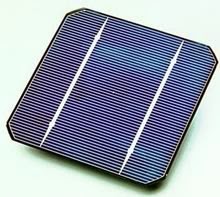As should be expected, a common question I am asked is: Thin Film vs Crystalline… what is the best solar panel to use?
There are essentially two types: Thin Film & Crystalline. Each have their own sub groups, like amorphous silicone & CIGS in the thin film realm, and poly crystalline and monocrystalline in the other. But what is the ‘best’? The answer is, as it always is… it depends.

Thin film cell
I know, that is not very satisfying. So I will look at the technologies from several different perspectives. This article outlines the metrics that people care about most when purchasing a solar charger and how the two primary solar technologies stack-up.
The question of Thin Film vs Crystalline can only be answered by you. Choose the performance parameters that are most important to you, and choose the technology that satisfies them the best.
1. Efficiency
The efficiency title goes to the crystalline solar cells.
Crystalline solar cells are upwards of 16-20% efficient in commercial-grade cells now, compared to something in the 8-10% range for the thin films.
However, you need to understand what this means. This does NOT mean that a 5W crystalline panel is more powerful than a 5W thin film. A Watt is a Watt after all, and in peak sun, two 5W panels will each be generating 5W of power regardless of the solar chemistry. A higher efficiency simply means that you will produce more Watts per square meter. The 5W thin film will be approximately twice the size of the 5W crystalline panel.
2. Weight
The weight loss winner is: Thin Film.
Even though the crystalline solar panel is half the size, it weighs more due to the rigid backing needed to protect the crystalline cell wafers & associated wiring. All that aluminum, plastic, resin, & PVC add to the weight of the crystalline solar panels. If only silicon wafers weren’t so fragile!
Thin films on the other hand can be laminated or even sprayed onto all sorts of surfaces. The result is solar panels that can be flexible, and add far less weight to your pack.
If you need to carry it, the thin film panels will be nicer to your knees.
3. Sensitivity
It’s not psychology, it’s chemistry… Thin films are more sensitive
This is a VERY IMPORTANT attribute, and one which should be considered carefully. Sensitivity simply means that the solar cells will start generating power in lower light levels. The practical side of this is that a thin film panel will enjoy a longer charging day than crystalline panels will.
An experiment to illustrate…
I ran a test of several different solar panels one drizzly morning in late May. I used a Powerfilm R-7 rollable, Brunton SolarFlat 5, Goal Zero Nomad 7, SunLINQ 3, and a Voltaic 3.4W panel.
The only panels that were producing enough voltage to charge a compatible battery pack at 10am on that drizzly, overcast, late spring morning were the thin films (Powerfilm, Brunton, SunLINQ). The crystalline panels were back at 50% of their nominal charging voltage.
Crystalline solar cells work best in direct sunlight.
Anything other than direct sunshine, and thin films are your best option.
4. Durability
I give the championship belt to… thin film.
This is a difficult parameter to gauge sometimes, because a lot depends on the construction of the product itself. But, when I think about which solar panels could survive being dropped off a cliff, there is no question that being lightweight & flexible has its advantages.
Durability is not to be confused with longevity… the 20-year power output warranty on rooftop crystalline panels is not yet matched by the thin films. Crystalline wafers lose their ability to generate power over a much longer time frame.
5. Cost
The winner is you.
What I mean by this is that product differentiation has rendered this parameter almost impossible to gauge. There are so many products for so many applications using so many variations of solar cells, that the only way to consider ‘cost’ properly is to shortlist products based on the above parameters, and then consider cost last. But, if we look at the cost of a basic framed panels to level the construction materials & manufacturing playing field, then we can see a slight advantage to crystalline panels. Maybe it has something to do with an over-supply of solar cells from China in recent years, but a quick web price search and calculation shows approx $5/Watt for crystalline, and $6/Watt for thin film.
How to choose?
I always start with the question: “Where are you going?”
If you are a westcoast Kayaker, or work in the mountains or up north where the weather is relatively unpredictable, you will likely find a more sensitive solar panel (ie thin film) to be your best option.
If you do education programs in rural Africa, or development missions to Haiti, where direct sunlight is not a problem, then crystalline panels may be your best value.
Match the size of the panel to your power needs by adding-up all your device requirements with a bit of room to spare. Then decide on a power storage battery(ies) to match. Be sure to read the product specifications, not just the marketing brochure.
Once you have these parameters sorted out, then consider the packability of the product, connectivity, etc.
Need any help choosing?
Send me a note!
Welcome to the Modern Outpost.



